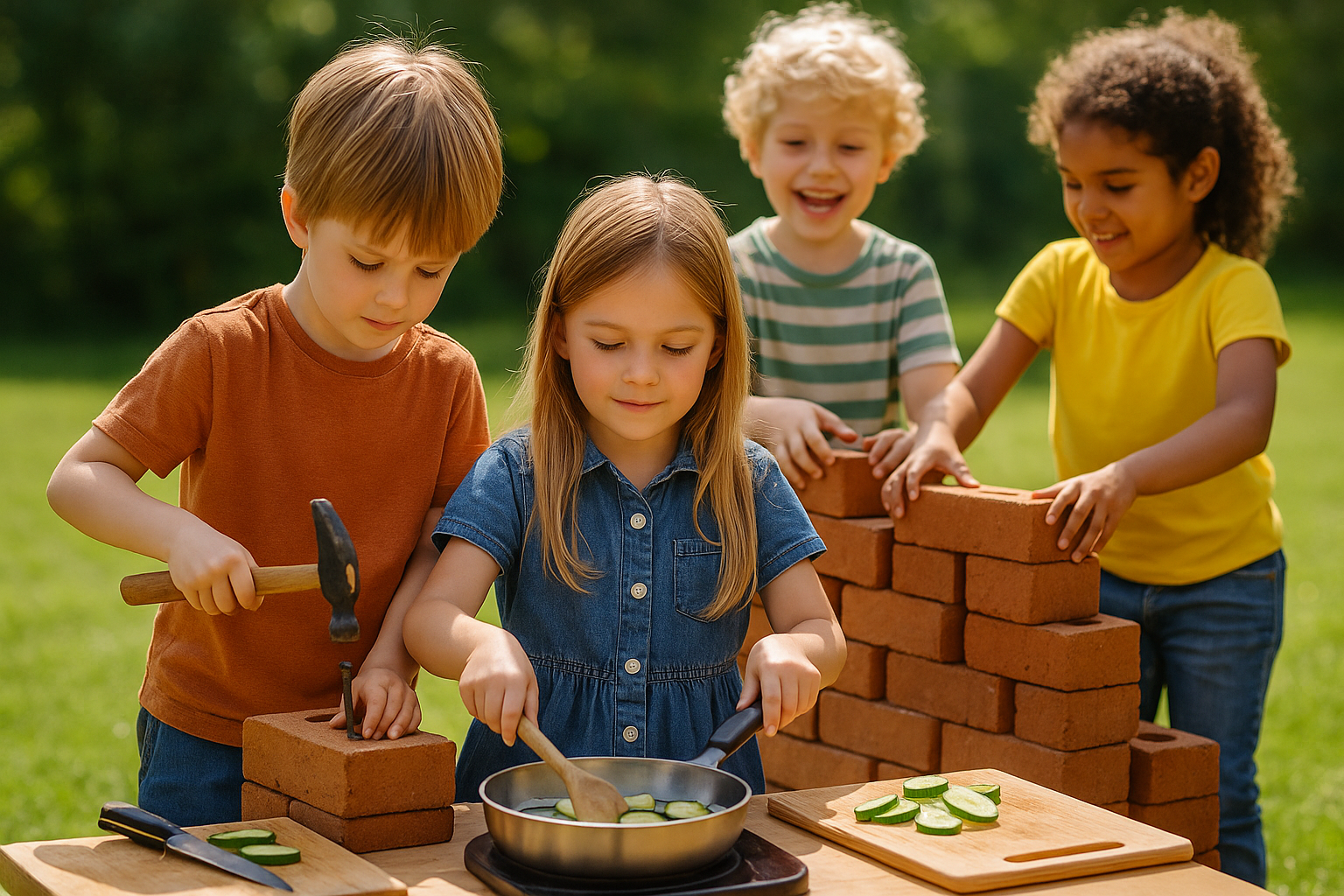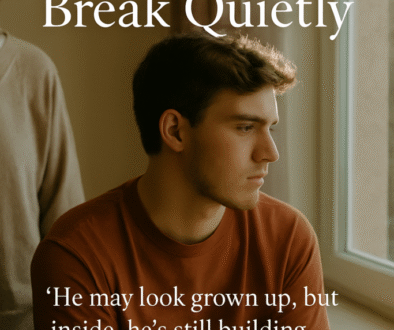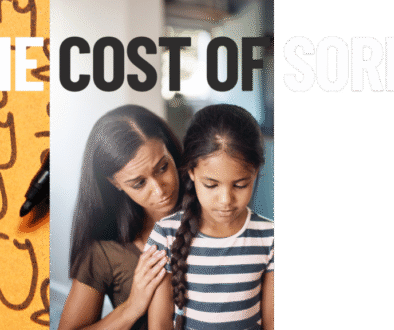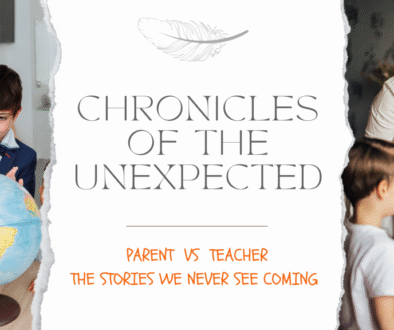
That's the Curriculum.
Let Them Fall. Spill. Lose Track. That’s the Curriculum.
There’s still a myth floating around — of that perfect preschool classroom where 3-year-olds don’t cry, don’t fall, speak in full sentences, sit cross-legged for 45 minutes, and write the alphabet without eating the markers.
Let me save you the wait: that room doesn’t exist. And it shouldn’t.
Because childhood is messy, loud, unpredictable — full of falls, pauses, broken glass, skinned knees, and spaghetti on the walls. That’s where real learning lives.
Give Them the Knife. And the Hammer.
Yes, you read that right.
Hand your child a butter knife and a cucumber. Or a child-safe hammer and soft wood with nails (yes, real ones). Give them yarn, buttons, pom-poms, and a plastic needle to stitch. They might get pricked. That’s okay.
Why? Because these aren’t “dangerous things” — they are life tools in tiny hands.
With supervision, something magical happens: children become calm, focused, and deeply intentional.
They don’t want to get hurt. They want to do what grown-ups do.
That’s brain development, coordination, sequencing, perseverance, and most importantly — a sense of agency.
Yes, Even Needle and Thread
Lacing, sewing, and threading are the queens of fine motor development. Give a child a plastic needle, some yarn, and felt — and you’ll witness a quiet mastery of focus.
Will they prick themselves? Maybe. Will they die? Absolutely not.
That tiny “ouch” teaches: “I got too excited. I didn’t slow down.”
Next time? Slower hands. Sharper attention. That’s emotional resilience stitched into the everyday.
Let the Glass Break. Let the Milk Spill.
Give a child a real glass — appropriately sized. It says, “We trust you. You’re capable. And if it breaks, we’ll learn something together.”
Yes, milk will spill. But they’ll learn:
-
To use two hands
-
To pour slowly
-
To clean up after themselves
-
To feel the weight and balance of a cup
-
To find the right angle to drink without spilling
-
To control the cup and adjust their posture to avoid spillage — which is basically toddler-level fluid dynamics
That’s executive function in action — no app needed.
And no — we don’t hold the cup for them. We let it fall, we mop it up, and we move on. That’s grace in growing.
To Them, It’s a Big Deal
Don’t say: “It’s not scary.” Or “It’s nothing.”
To them? It’s everything. That bee. That hand dryer. That clown? Could be a monster.
Instead of minimizing — name the feeling and stay present.
“That startled you. I’m here. You’re safe.”
That’s emotional safety — built not by suppressing fear but by acknowledging it.
We hold space, not the solution. We honour their perception — even if it sounds silly to our grown-up ears.
Let Them Speak… Even If It Takes Forever
You: “And then what happened?”
Child: “Umm… the… someone… boy… not that… the other…” (pause) “I forgot.”
You sigh. But that’s the brain wiring in real time.
Don’t interrupt. Don’t finish it for them.
Your silence is room to grow. Your patience says: “Your words matter. You’re worth listening to.”
Even if the story takes forever. Even if it fizzles out with “I forgot.”
Because what they really learned is that you care. That what they say is worth your time. And they’ll come again. And again.
That’s the beginning of trust and self-worth.
Falling, Refusing, Fighting — That’s Learning
They refuse to eat? Great — they’re tuning into body cues.
Don’t run behind them with a spoon. They’re children, not ducks.
Arguing over a toy? Instead of jumping in like the UN, try:
-
Get close
-
Say little
-
Observe
They might solve it. They might not. But they’re learning negotiation, emotion, and communication.
Don’t always be the fixer. Be the silent spectator. Give them a chance to try — and sometimes fail.
Because resilience is not built when we always help — but when they see they can help themselves.
Sun, Rain, Mud, and Cold — Nature Is the Original Classroom
Stop checking the weather like it’s a natural disaster report.
Sunny? Great. Raining? Even better. Cold? Hats on.
Children aren’t sugar cubes — they won’t melt.
They’ll trip? Good. Get messy? Even better. Lose a shoe? Fantastic. A memory for life.
Falling in the mud, climbing that big rock, feeling the rain down their back — it builds body intelligence, balance, immunity, and pure joy.
Parents — we love your children. No one wants them hurt. But when it happens — trust us. We’re more gutted than you know.
But they must fall. That’s neurology and courage in motion.
What Fear Takes Away — Real Skills
Because of certain restrictions and fears around hurting little ones, many schools are simply unable to offer what children truly need. Even if educators want to try experiments, they’re often not allowed.
Take fire — many schools don’t even allow birthday candles, let alone simple, magical fire experiments that teach safety, chemistry, and awe.
But in other parts of Asia, children are cutting vegetables, using real knives, lighting stoves, baking, cleaning — all by themselves.
And what do we feel when we watch those videos online? Amazement. Beauty. A sense of wonder. Then why don’t we let our own children do the same?
How long will we do everything for them? Tie their shoes? Feed them? Wipe their faces? Dress them like dolls?
Making bed didi, feeding didi, dressing up didi — it’s not a luxury service. It’s basic self-care we’re denying them.
These are natural, human tasks. Yet, so many children are deprived of them.
Why? Why don’t we trust our own kids? Why so much fear?
I know children still in diapers at five years old — and not for medical reasons. It’s not that they can’t. It’s that we don’t let them.
(And let’s be honest — if they can operate your phone and skip YouTube ads, they can handle a potty.)
Being aware of what is dangerous — and learning how to use it safely — makes a child more responsible, not less.
It teaches self-control, caution, and attention. When we shield children from everything, we don’t protect them — we weaken them.
And this isn’t an abstract theory — these are real observations from Gurgaon, where I work and live.
This Is the Curriculum
All of this — the spilled milk, the threading, the pokes, the muddy clothes, the long-winded stories, the silences and the chaos — is early childhood education.
It’s not a PDF. Not a worksheet. Not the alphabet song at age three (though it’s cute).
The real curriculum is life. Trust children to figure it out. Trust yourself to know when not to jump in.
Together, let’s create a childhood worth remembering — not just certifying.
And maybe next time, when your child comes in muddy, loud, full of stories and bruises, you’ll smile — and say:
“Looks like you’ve had a great day.”


